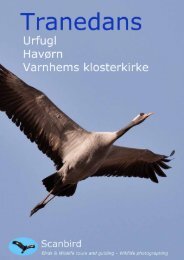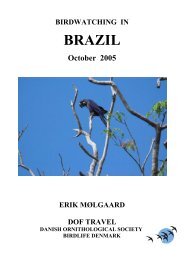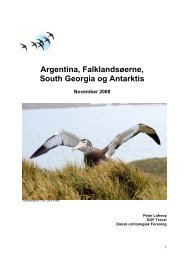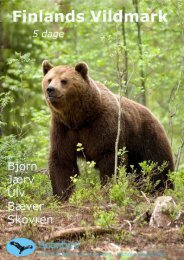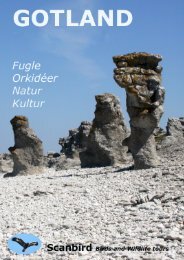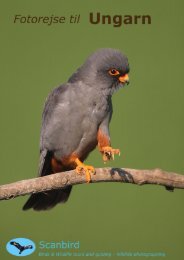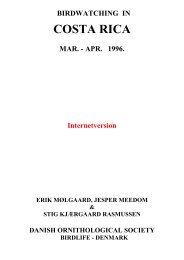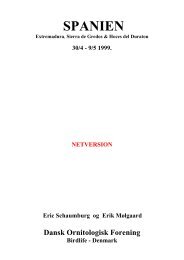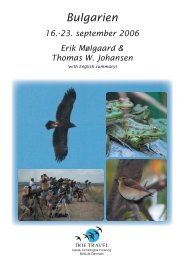Birding Southern Sweden (large PDF file (5 MB) - Tåkerns Fältstation
Birding Southern Sweden (large PDF file (5 MB) - Tåkerns Fältstation
Birding Southern Sweden (large PDF file (5 MB) - Tåkerns Fältstation
You also want an ePaper? Increase the reach of your titles
YUMPU automatically turns print PDFs into web optimized ePapers that Google loves.
Certain species and their status:<br />
Black-throated Diver, 70 pairs<br />
Great Crested Grebe, 100 pairs<br />
Whooper Swan<br />
Greylag Goose, 50 pairs<br />
Lesser White-throated Goose, migration<br />
Bean Goose, migration<br />
Goosander, 70 pairs, >10 000 in autumn<br />
Honey Buzzard, 20–25 pairs<br />
Red Kite<br />
White-tailed Eagle<br />
Marsh Harrier, 7–8 pairs<br />
Osprey, 50 pairs<br />
Hobby, 15 pairs<br />
Water Rail<br />
Spotted Crake<br />
Curlew 10–15 pairs<br />
Little Gull<br />
Common Tern 50 pairs<br />
Black Tern<br />
Lesser Spotted Woodpecker 20–25 pairs<br />
Red-breasted Flycatcher<br />
PER-ERIK LARSSON<br />
Lake Åsnen<br />
Lake Åsnen is one of the <strong>large</strong>st lakes in southern <strong>Sweden</strong> and<br />
boasts a magnificent archipelago. The lake contains a number<br />
of shallow and irregular coves. The average lake depth is only 3<br />
metres, while there are hundreds of islands in the lake. The total<br />
shoreline length along the coves and islands amounts to a distance<br />
of about 700 km. The size of the lake and the low number<br />
of inhabitants contributes to its natural wilderness.<br />
It is surrounded <strong>large</strong>ly by coniferous and deciduous forest<br />
that is home to a rich and diverse bird life. In the northern regions<br />
of the lake, close to Skatelöv cove, one can find <strong>large</strong> open<br />
countryside. This is ideal for waders, ducks and geese, especially<br />
during migration periods.<br />
The lake is rich in nutrients and fish. The <strong>large</strong> supply of fish<br />
has, in part, an impact on bird life. Osprey and Black-throated<br />
Divers nest in the lake, while during late autumn and winter,<br />
thousands of Goosander and a <strong>large</strong> number of White-tailed<br />
Eagles fish in the lake.<br />
Lake Åsnen is one of about 30 wetlands in <strong>Sweden</strong> that is<br />
protected by the international Ramsar convention. The lake is<br />
also included in Bird Life International’s list of Important Bird<br />
Areas (IBA).<br />
PER-ERIK LARSSON<br />
Greylag Geese are a common visitor to the shores of Lake Åsnen.<br />
Bird species that comply with the criteria defined in the IBA<br />
are Goosander, Osprey, White-tailed Eagle, and Bean Goose.<br />
The rare fishing-eating Otter Lutra lutra can also be found in<br />
the lake.<br />
The main attraction in the lake are the around 50 pairs of<br />
Osprey that nest here, one of Europe’s <strong>large</strong>st collective groups.<br />
Other birds of prey nesting on the shores of Lake Åsnen are the<br />
Honey Buzzard, the Hobby and the Red Kite. The White-tailed<br />
Eagle has also begun nesting by the lake in the past number of<br />
years. During late autumn and winter, a <strong>large</strong> number (20 to<br />
40) of White-tailed Eagles can be seen at the lake. They are<br />
attracted by the open, fish-abundant waters and by the carrion<br />
that is laid out by ornithologists during the winter months. The<br />
lake may also receive a visit from a number of Golden Eagles at<br />
this time.<br />
The <strong>large</strong> number of islands and the abundance of fish provides<br />
the Black-throated Diver with ideal nesting conditions, with<br />
approx. 70 pairs nesting around the lake.<br />
Lake Åsnen is also an important resting area for the Goosander<br />
during the autumn and winter months. Large flocks of between<br />
4,000 and 6,000 birds, at times up to 20,000, fish and rest<br />
at the lake, until it freezes over.<br />
At the outset of the century, the Greylag Goose was quite a<br />
rare nesting bird in these parts, but in recent decades, it has<br />
increased in number and can now be seen quite often in the<br />
area. The Bean Goose is the most common species of goose that<br />
uses Lake Åsnen as a resting point on their migration back and<br />
forth from nesting spots in the northern tundra. The geese rest<br />
PER-STEFAN HALLBERG<br />
8



